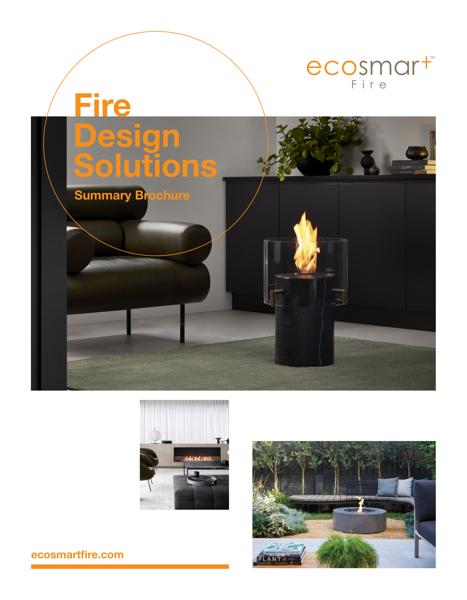Loading image...


Create an instant talking point
Because bioethanol is clean-burning, EcoSmart Fire models do not need a chimney or a flue, or a utility connection – offering the ultimate in design simplicity and flexibility.
Whether you're creating a custom fireplace feature, renovating an existing fireplace, or looking for an out-of-the-box solution, we have an ethanol fireplace to suit your needs.
You May Also Like
Learn More
Ethanol Fireplaces
Ventless Fireplaces
FAQ's
What are the pros and cons of ventless fireplaces?
Ventless ethanol fireplaces provide outstanding installation flexibility, requiring no chimney, flue, or fixed utility connection—making them ideal for apartments and contemporary interiors. They burn bioethanol cleanly, emitting no smoke, soot, or ash. However, as they consume oxygen during operation, it is essential to ensure proper ventilation in the room to prevent indoor air pollution. Always follow the minimum room size and ventilation guidelines specified by the manufacturer. These fireplaces are designed for decorative or supplemental heating, not as a primary heat source.
Are ventless fireplaces safe?
Ventless ethanol fireplaces are safe when properly installed and operated according to manufacturer guidelines. EcoSmart Fire's bioethanol fireplaces meet rigorous safety standards including UL 1370-16 and EN16647 certification. Always ensure sufficient room size and follow all safety protocols.
Can I convert my existing fireplace to bioethanol?
Yes, you can easily convert your existing fireplace to bioethanol using EcoSmart's VB2 burner, Heritage Grates, or Fireplace Grates. These products transform traditional wood-burning fireplaces into clean-burning bioethanol fires within minutes. Just ensure any gas connections are professionally disconnected first for safety.
Is the ethanol fireplace heat output similar to a gas heater?
Burning bioethanol is similar to gas, but the room doesn't dry out as it does with gas - a more gentle, softer heat is created. Heat-wise, it depends on the models being compared. Some of our bioethanol burners output 15,000 BTU and can heat up to 60sqm of living space. Bioethanol is not, however, on an adjustable thermostat. Some may be turned up and down, but you can't control the room temperature in the same way as you do with gas on mains.
How long does it take to assemble an ethanol fireplace?
There is virtually no assembly. Our freestanding fireplaces and fireplace grates are designed to be placed into the desired location, secured into position, and operated immediately. Our fireplace inserts are designed to slot into place, secured and built around your preferred finish – again a quick and easy installation – so your builder or interior designer will love you!The longest part of the setup process is trying to figure out where you want to place it – be sure it complies with our clearance requirements, particularly with regard to moving objects like curtains, tree branches and so forth.
Can I refill my bioethanol fireplace while it's running?
No, you must never refill your bioethanol fireplace while it's running. This poses serious explosion and fire hazards that could result in property damage, injury, or death.Always shut off the appliance and allow it to cool for at least 60 minutes before refuelling. The flame may be difficult to see in daylight conditions, so never assume the burner is off. Even when the flame appears extinguished, the burner remains dangerously hot and volatile vapours may still be present.
How long will my ethanol fireplace burn?
Burn times for our ethanol fireplaces vary based on flame size and fuel capacity of the burner. EcoSmart Fire’s ethanol fireplaces will burn between 8-13 hours when full.
Do ethanol fireplaces smell?
All heating appliances have their own smell be it gas, wood or electric - ethanol fireplaces are no different. e-NRG ethanol fuel is made of fermented plants like sugarcane or corn and is essentially a liquid alcohol. To safely make it “de-natured” and unfit for consumption, substances have been added. The burning of these substances may cause a slight smell upon initial lighting and when the flame is extinguished – similar to when you blow out a candle. e-NRG ethanol fuel is the only fuel recommended for your EcoSmart Fire ethanol fireplace. e-NRG ethanol fuel has the lowest odour and longest burn time on the market. The nice thing about using ethanol is that it’s not dry like gas or smokey like wood.
Will my ethanol fireplace heat the room?
All EcoSmart Fires are ventless, meaning all the heat stays in the room rather than escaping up a flue. Increased heat retention means increased fuel efficiency and a better chance of staying warm. While providing warmth, EcoSmart Fires are not designed to be used as a room’s primary heat source. Please see the burner section in our manual for full details.
Are bioethanol fireplaces safe for homes with children or pets?
Like all fireplace solutions, bioethanol fireplaces can be safe with proper precautions around children and pets. EcoSmart Fire recommends installing certified fire screens, maintaining safe distances from hot surfaces, and never leaving the fire unattended. Children should always be supervised, and pets kept away from the unit during operation due to high surface temperatures.



























